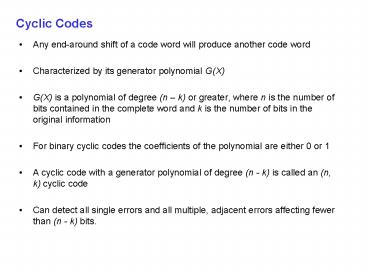Cyclic Codes - PowerPoint PPT Presentation
1 / 5
Title: Cyclic Codes
1
Cyclic Codes
- Any end-around shift of a code word will produce
another code word - Characterized by its generator polynomial G(X)
- G(X) is a polynomial of degree (n k) or
greater, where n is the number of bits contained
in the complete word and k is the number of bits
in the original information - For binary cyclic codes the coefficients of the
polynomial are either 0 or 1 - A cyclic code with a generator polynomial of
degree (n - k) is called an (n, k) cyclic code - Can detect all single errors and all multiple,
adjacent errors affecting fewer than (n - k)
bits.
2
Cyclic Codes
- Suppose that code word
. It corresponds to the polynomial V(X) where - Each n-bit code word is represented by a
polynomial of degree (n 1) or less. - The polynomial V(X) is called the code polynomial
of the code word v
3
Cyclic Codes
- The code polynomials for a nonseparable cyclic
code are generated by multiplying a polynomial
representing the data by another polynomial known
as the generator polynomial - The code polynomial is generated by multiplying
the data polynomial by the generator polynomial
and adding the coefficients in the modulo-2
fashion - Example Generator polynomial,
and need to encode the binary
data 1101 - Data polynomial
and V(X) D(X) G(X) - v (10100001)
4
Cyclic Codes
5
Cyclic Codes

